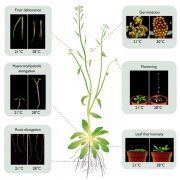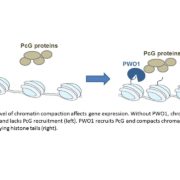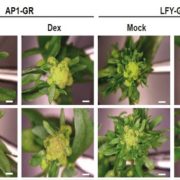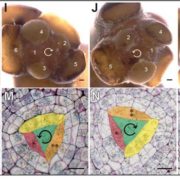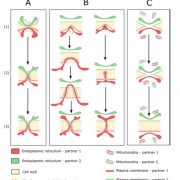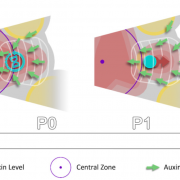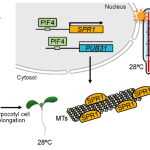Anisotropic cell growth at the leaf base promotes age-related changes in leaf shape
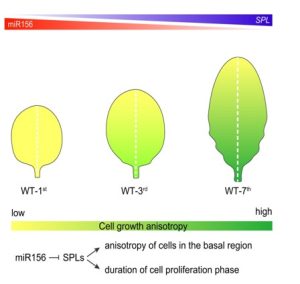 The Arabidopsis thaliana leaf exhibits dramatic phenotypic changes across the juvenile-to-adult phase transition during vegetative development. For example, juvenile leaves are small, round, and lack trichomes (leaf hairs). By contrast, adult leaves contain trichomes on the abaxial (or lower) leaf surface, serrations on the leaf margin, and a lengthened leaf blade. The switch between the juvenile and adult phases is regulated by the conserved miR156-SQUAMOSA PROMOTER BINDING PROTEINS-LIKE (SPLs) pathway. It has been shown that miR156 promotes the juvenile leaf phase. However, it is still unknown how SPLs specify adult leaf shape. Tang et al. used quantitative analyses of juvenile and adult leaves using MorphoLeaf software, overexpression lines, reporter lines, mutants, ChIP-seq, and computational modeling. They showed that miR156-targeted SPLs sufficiently promote cell expansion oriented along the abaxial leaf surface (cell growth anisotropy) and cell proliferation at the base of the blade which contributes to the adult leaf shape. In addition, ChIP-seq data shows that SPL10 might regulate leaf changes by activating genes involved in the cell cycle such as CYCLIND3 (CYCD3) and cell wall properties such as xyloglucan endotransglucosylase/hydrolase (XTH). Collectively, these results indicate that SPLs are important for the formation of the final shape of an adult leaf. (Summary by Andrea Gómez-Felipe @andreagomezfe) Plant Cell 10.1093/plcell/koad031
The Arabidopsis thaliana leaf exhibits dramatic phenotypic changes across the juvenile-to-adult phase transition during vegetative development. For example, juvenile leaves are small, round, and lack trichomes (leaf hairs). By contrast, adult leaves contain trichomes on the abaxial (or lower) leaf surface, serrations on the leaf margin, and a lengthened leaf blade. The switch between the juvenile and adult phases is regulated by the conserved miR156-SQUAMOSA PROMOTER BINDING PROTEINS-LIKE (SPLs) pathway. It has been shown that miR156 promotes the juvenile leaf phase. However, it is still unknown how SPLs specify adult leaf shape. Tang et al. used quantitative analyses of juvenile and adult leaves using MorphoLeaf software, overexpression lines, reporter lines, mutants, ChIP-seq, and computational modeling. They showed that miR156-targeted SPLs sufficiently promote cell expansion oriented along the abaxial leaf surface (cell growth anisotropy) and cell proliferation at the base of the blade which contributes to the adult leaf shape. In addition, ChIP-seq data shows that SPL10 might regulate leaf changes by activating genes involved in the cell cycle such as CYCLIND3 (CYCD3) and cell wall properties such as xyloglucan endotransglucosylase/hydrolase (XTH). Collectively, these results indicate that SPLs are important for the formation of the final shape of an adult leaf. (Summary by Andrea Gómez-Felipe @andreagomezfe) Plant Cell 10.1093/plcell/koad031


